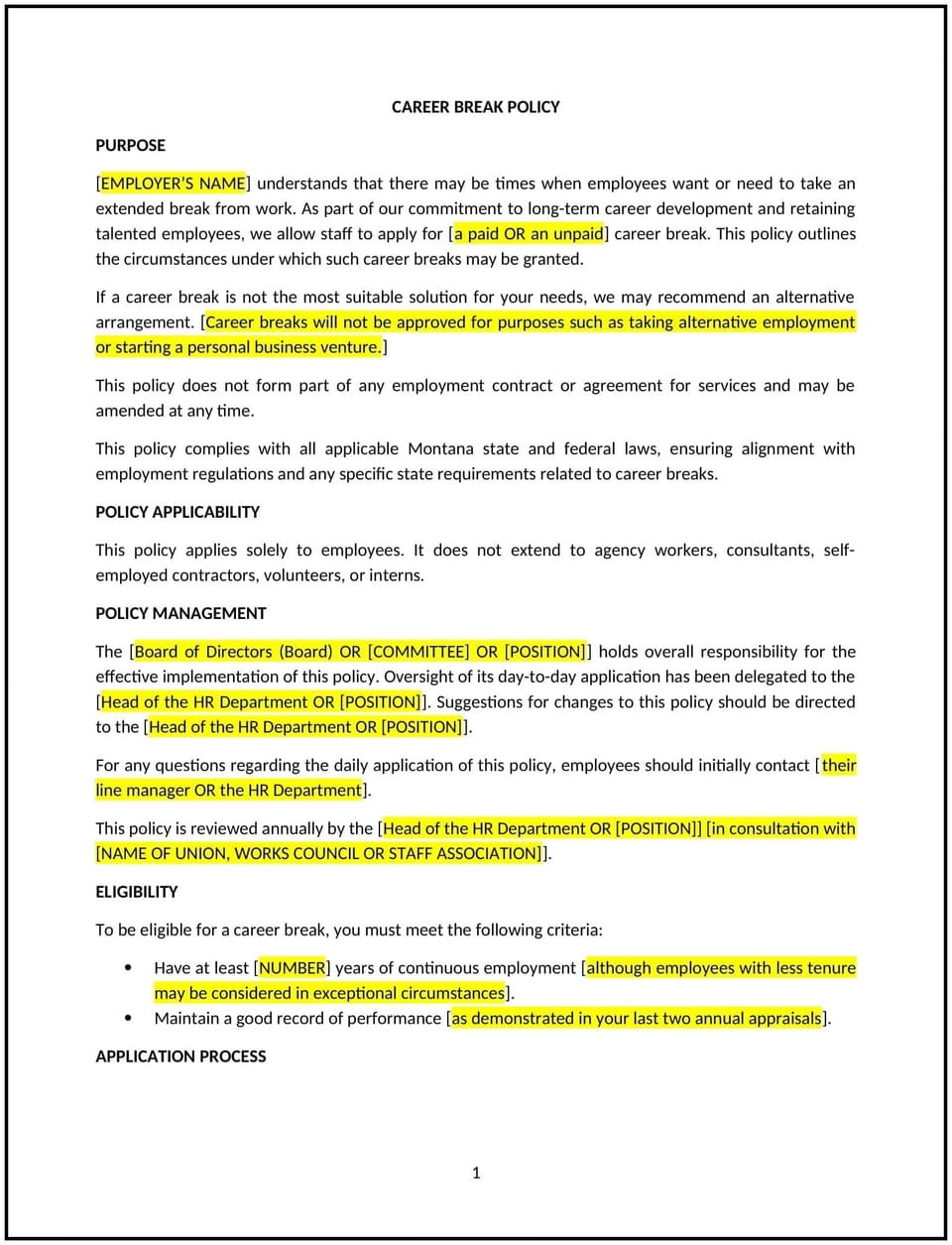Career break policy (Montana): Free template

Career break policy (Montana)
A career break policy helps Montana businesses provide employees with the opportunity to take an extended, unpaid leave of absence for personal or professional reasons. This policy outlines eligibility criteria, the application process, and the terms for returning to work. It allows businesses to support employees while maintaining workforce planning and operational continuity.
By implementing this policy, businesses can retain valued employees, promote work-life balance, and manage career break requests fairly and consistently.
How to use this career break policy (Montana)
- Define eligibility: Businesses should specify which employees qualify for a career break, such as those with a certain length of service or in eligible roles. The policy should clarify whether breaks are available to full-time, part-time, or contract employees.
- Establish the application process: Employees should submit a written request outlining the reason for the career break, proposed duration, and intended return date. Businesses should require reasonable notice to allow for workforce planning.
- Set the duration and conditions: Businesses should determine the maximum length of a career break, such as six months to two years, and whether employees may request extensions. The policy should clarify whether employees maintain certain benefits during their leave.
- Outline job protection and return-to-work procedures: Businesses should specify whether employees will be guaranteed their previous position or a similar role upon return. The policy should address any re-induction or retraining required.
- Address financial and benefit considerations: Businesses should communicate whether employees may continue healthcare or retirement benefits during a career break and whether they are responsible for covering costs.
- Define restrictions during the break: Businesses should clarify whether employees may work for another employer, pursue education, or engage in other activities while on leave.
- Review and update regularly: Businesses should periodically assess the policy to ensure it remains aligned with workforce needs and industry best practices.
Benefits of using this career break policy (Montana)
This policy provides several key benefits for Montana businesses:
- Retains experienced employees: Career breaks allow businesses to keep skilled employees who may otherwise resign.
- Supports work-life balance: Employees have the opportunity to manage personal responsibilities, pursue education, or travel without permanently leaving their role.
- Improves employee engagement: Businesses that offer flexible leave options foster a positive work culture and higher job satisfaction.
- Reduces recruitment and training costs: Allowing employees to return after a break minimizes the need for new hires and onboarding expenses.
- Establishes clear expectations: Employees and managers understand the conditions of career breaks, reducing uncertainty and miscommunication.
- Enhances business reputation: Businesses that provide career break options are more attractive to top talent seeking long-term career flexibility.
Tips for using this career break policy (Montana)
- Communicate eligibility requirements clearly: Businesses should ensure employees understand the qualifications for requesting a career break.
- Require advance notice: Businesses should establish reasonable timelines for submitting career break requests to allow for workforce adjustments.
- Set clear expectations for return-to-work: Employees should understand whether their previous role will be available or if they will need to apply for open positions.
- Encourage professional development: Businesses may allow employees to pursue education or training during their career break to enhance their skills.
- Maintain contact during the break: Businesses should provide optional check-ins to keep employees informed about workplace updates.
- Review policy effectiveness: Businesses should assess how career breaks impact workforce planning and adjust the policy as needed.
Q: Why should Montana businesses implement a career break policy?
A: Businesses should implement a career break policy to retain skilled employees, provide work-life balance options, and reduce recruitment and training costs.
Q: How long should businesses allow employees to take a career break?
A: Businesses should define the maximum duration of a career break, typically ranging from six months to two years, based on operational feasibility.
Q: Can employees return to the same job after a career break?
A: Businesses should clarify whether employees will be guaranteed their previous position or placed in a similar role upon returning from a career break.
Q: Should businesses require employees to provide a reason for a career break?
A: Businesses should request a general explanation for workforce planning purposes but should not require employees to disclose personal details.
Q: How should businesses handle benefits during a career break?
A: Businesses should determine whether employees may continue healthcare, retirement, or other benefits and whether they are responsible for covering costs.
Q: Can employees work elsewhere during their career break?
A: Businesses should specify any restrictions on secondary employment during a career break, particularly in cases where conflicts of interest may arise.
Q: What happens if an employee decides not to return after a career break?
A: Businesses should outline a resignation process for employees who choose not to return, ensuring a smooth transition for both parties.
Q: Should businesses maintain contact with employees on career breaks?
A: Businesses should offer optional check-ins to keep employees informed of workplace changes and discuss their return-to-work plans.
Q: Can employees request an extension for their career break?
A: Businesses should determine whether career break extensions are permitted and establish an approval process for such requests.
Q: How often should businesses review their career break policy?
A: Businesses should review the policy annually or as workforce needs change to ensure it remains practical and effective.
This article contains general legal information and does not contain legal advice. Cobrief is not a law firm or a substitute for an attorney or law firm. The law is complex and changes often. For legal advice, please ask a lawyer.


